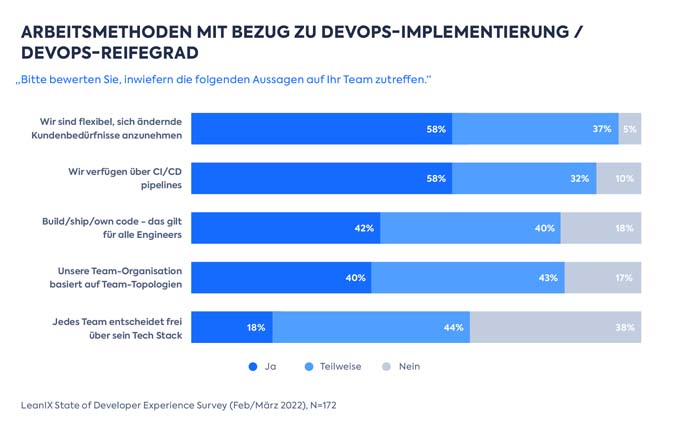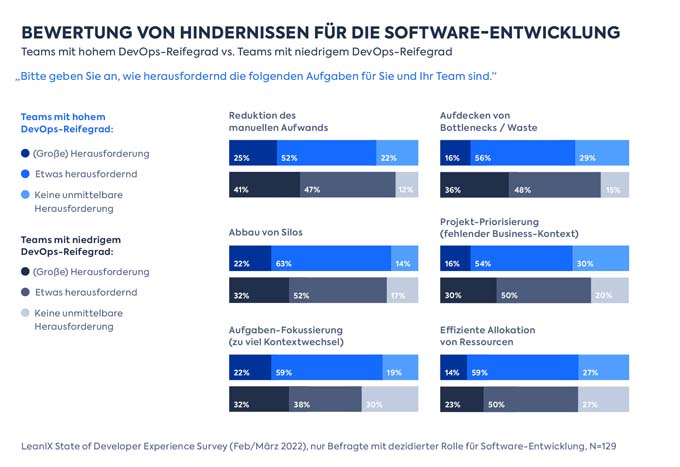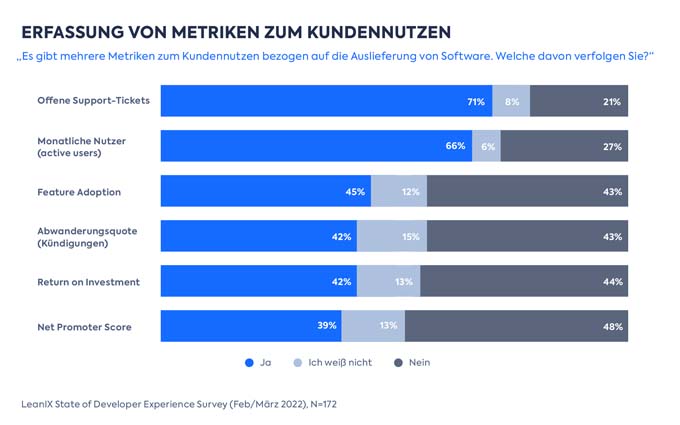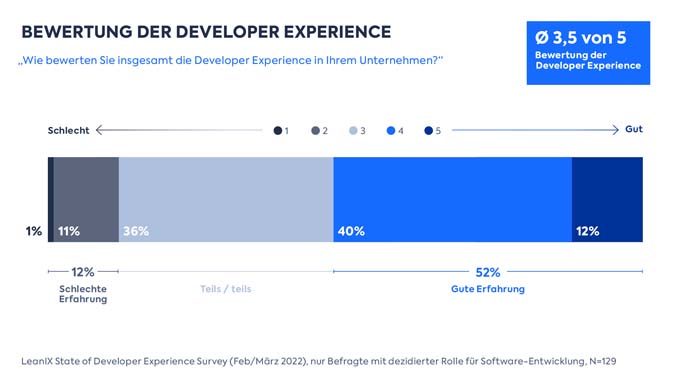Many companies lack a comprehensive DevOps culture
Modern software development thrives on DevOps initiatives and agile working methods. But a recent study shows that this potential is far from being exploited in international companies: Less than half of the developer teams surveyed are already using the relevant working methods comprehensively and have a correspondingly high DevOps maturity level.

Companies are wasting potential in software development: Less than half have a comprehensive DevOps culture. This is shown by the State of Developer Experience Survey 2022 from LeanIX. According to this study, most respondents apply the methods characteristic of DevOps only sporadically and complain more frequently that obstacles become a challenge in their daily work. Considering the importance of software development for achieving business goals, it is alarming that the majority of development teams have little insight into the immediate customer benefits of their work, the study concludes. Few metrics are available, and software development efficiency is also poorly measured. A quarter of the respondents do not identify one of the four recognized DORA metrics. The lack of such metrics on customer value and efficiency makes communication difficult: for example, only 42 percent of respondents say that IT and business speak the same language in their company. The LeanIX State of Developer Experience Survey, conducted for the first time in 2022, makes it clear: A little DevOps is not enough - and a stronger focus on it can decisively improve software development.
Potential of DevOps is not exploited in daily work
The study participants were asked about the use of five characteristic working methods for DevOps - with sobering results:

Nearly 60 percent of the respondents state that they can react flexibly to changing customer requirements and that they have CI/CD pipelines. However, flexibility with regard to the customer and the ability to execute and test changes to the code automatically via CI/CD pipelines is central to DevOps initiatives. It is therefore notable that for more than 40 percent of teams, this basic requirement is only partially met or not met at all. The picture is even worse when it comes to the "build-ship-own your code" principle typical of DevOps, team organization based on team topologies or the free choice of tech stack. In summary, DevOps initiatives can be expanded in international companies.
DevOps maturity level influences perception of obstacles at work
If we look at the five working methods queried, we see that the majority of developer teams (53 percent) use only up to three of these methods. This low DevOps maturity level has an influence on the assessment of obstacles in daily work. Respondents from such teams consistently rate these as a greater challenge:

Reducing manual effort due to lack of automation - this is at the top of the list of obstacles described as a "major challenge" for all respondents. However, teams with a lower DevOps maturity level perceive this significantly more strongly, at 41 percent versus 25 percent. Whether breaking down silos or the difficulty of focusing on one's tasks due to frequent changes in context, whether uncovering bottlenecks, the challenge of prioritizing projects or allocating resources efficiently: in theory, agile ways of working lead to the elimination or significant reduction of these obstacles. The fact that the majority of respondents describe these issues as challenging is another indication that DevOps teams are still on a journey. This is where those responsible can start to further improve and accelerate software development in the company.
There is a lack of a common language between IT and business
Successful DevOps initiatives require collaboration with all stakeholders in the company - Gartner analysts point this out. They note that many initiatives also fail because the expectations associated with them are not clearly defined within the company. To manage these expectations, IT and business should agree on common goals and metrics - and thus on a common language, the experts demand.
However, it is precisely this common language that is lacking in companies: Only 42 percent of the respondents in this study state that IT and business understand each other. If you look at which metrics are recorded at all and examined more closely, the lack of a basis for understanding becomes obvious.
Little insight into customer value and software development efficiency
About 70 percent of developer teams look at two metrics in relation to the customer and their work: open support tickets and monthly active users - easily accessible metrics that hold the most potential for frustration and do not directly relate to the software delivered and its value to the customer:

Whether it's feature adoption, churn rate, return on investment, or Net Promoter Score as an expression of satisfaction, each of these metrics is looked at by less than half of software development teams. So most teams have little insight into the actual success and customer value of their specific work performance - and can't share it with the business.
The ability to measure software development performance using the four recognized DORA metrics (Deployment Frequency, Failure Rate, Lead Time for Changes, Mean Time to Recovery) is also not widely perceived. A quarter of the respondents do not even consider one of these metrics. Yet such a measurement of performance would also contribute to a common language that makes mutual appreciation possible in the first place.
Different data sources complicate the overview
The necessary information for relevant customer key figures or the DORA metrics is often spread across various sources. Their collection often involves a great deal of manual effort - and in almost 40 percent of cases even Excel spreadsheets.
Modern value stream management platforms could help. But only 20 percent of respondents are already using them to link data streams together in an automated way and to establish the direct link to business results.
Expand agile ways of working despite predominantly positive developer experience
No comprehensive DevOps implementation, hurdles in daily work, little insight into the direct customer benefit of the developed software - despite this situation in the developer teams, the slight majority of respondents generally rate the developer experience rather positively:

What sounds good at first, however, a closer look also shows that almost half of the respondents cannot decide on a positive assessment. Against the backdrop of a massive shortage of skilled IT staff and the increasing importance of software as a differentiator on the market, companies should do everything in their power to retain their software development teams.









